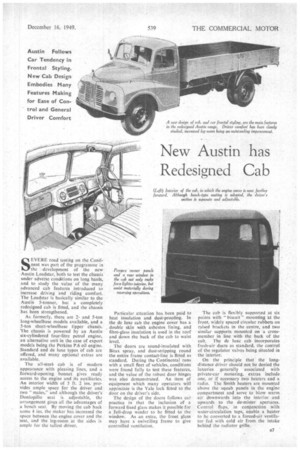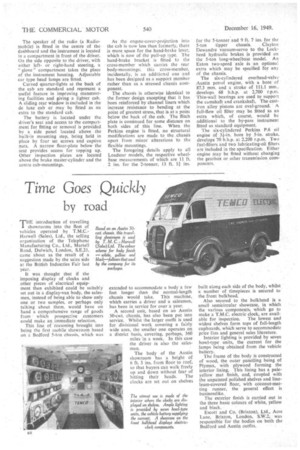New Austin has Redesigned Cab
Page 41

Page 42

If you've noticed an error in this article please click here to report it so we can fix it.
SEVERE road testing on the Continent was part of the programme in the -development of the new .. Austin Loadstar, both to test the chassis under adverse conditions on long hauls, and to study the value of the many advanced cab features introduced to increase driving and riding comfort. The Loadstar is basically similar to the Austin 5-tonner, but a completely redesigned cab is fitted, and the chassis has been strengthened.
As formerly, there are 2and 5-ton long-wheelbase models available, and a 5-ton short-wheelbase tipper chassis. The chassis is powered by an Austin six-cylindered four-litre petrol engine, an alternative unit in the case of export models being the Perkins P.6 oil engine. Standard and de luxe types Of cab are offered, and many optional extras are available.
The all-steel. cab is of modern appearance with pleasing lines, and a forward-opening bonnet gives ready access to the engine and its auxiliaries. An interior width of 5 ft. 2 ins provides ample space for the driver and two " mates," and although the driver's Dunlopillo seat is adjustable, the arrangement gives all the advantages of a bench seat. By moving the cab back some 4 ins the maker has increased the space between the engine cover and the seat, and the leg-room at the sides is ample for the tallest driver,
Particular attention has been paid to heat insulation and dust-prooting. In the de luxe cab the engine cover has a , double skin with asbestos lining, and fibre-glass insulation is used in the roof and down the back of the cab to waist The doors are sound-insulated with Bitax spray, and dust-stripping round the entire frame contact-line is fitted as standard. During the Continental runs with a small fleet of vehicles, conditions were found fully to test these features, and the value of the robust door hinges was also demonstrated. An item of equipment which many operators will appreciate is the Yale lock fitted to the door on the driver's side.
The design of the doors follows Car practice in that the inclusion of a forward fixed glass makes it possible for a .full-drop winder to be fitted to the window. As an extra, the front glass may have a swivelling frame to give controlled ventilation.
The cab is flexibly supported at six points with " biscuit" mounting at the front, widely spaced circular rubbers on raised brackets in the centre, and two similar supports mounted on a crossmember in line with the back of the cab. The de luxe cab incorporates fresh-air ducts as standard, the control of the regulator valves being situated in the interior.
On the principle that the longdistance driver should not be denied the luxuries generally associated with private-car motoring, extras include one, or if necessary two heaters and a radio. The Smith heaters are mounted above the squab panels in the engine compartment and serve to blow warm air downwards into the interior and upwards to the de-mister apertures. Control flaps, in conjunction with water-circulation taps, enable a heater to be converted to a forced-air ventilator fed with cold air from the intake behind the radiator grille.
The speaker of the radio (a Radiomobile) is fitted in the centre of the dashboard and the instrument is located in a compartment in front of the driver. On the side opposite to the driver, with either leftor right-hand steering, a " glove" compartment takes the place of the instriament housing. Adjustable car type head lamps are fitted.
Curved quarter-lights at the back of the cab are standard and represent a useful feature in improving manceuvring facilities and giving a lighter cab. A sliding rear window is included in the de luxe cab or may be fitted as an extra to the standard cab.
The battery is located under the driver's seat and access to the compartment for fitting or removal is provided by a side panel located above the built-in mounting step, being held in place by four set screws and captive nuts. A narrow floor-plate below the Seat provides access for topping up. Other inspection plates are located above the brake master-cylinder and the centre cab-mountings.
As the engine-cover-projection into the cab is now less than formerly, there is more space for the hand-brake lever, which is now of the pull-up type. The hand-brake bracket is fitted to the cross-member which carries the rear body-mountings; this cross-member. incidentally, is an additional one and has been designed as a support member rather than as a stressed chassis component.
The chasnis is otherwise identical to the former design excepting that it has been reinforced by channel liners which increase resistance to bending at the point of greatest stress, that is at a point below the back of the cab. The flitch plate is continued for some distance on both sides of this line. When the Perkins engine is fitted, no structural modifications are made to the chassis apart from minor alterations to the flexible mountings.
The foregoing details apply to all Loadstar models, the respective wheelbase measurements of which are 11 ft. 2 ins, for the 2-tonner, 13 ft. l ins.
for the 5-tonner and 9 ft. 7 ins, for the 5-ton tipper chassis. Clayton Dewandre vacuum-servo to the Lockheed hydraulic brakes is provided on the 5-ton long-wheelbase model. An Eaton two-speed axle is an optional extra which may be specified for any of the chassis.
The six-cylindered overhead-valve Austin petrol engine, with a bore of 87.3 mm. and a stroke of 111.1 mm., develops 68 b.h.p. at 2,700 r.p.m. Thin-wall bearings are used to support the camshaft and crankshaft. The castiron alloy pistons are oval-ground. A full-flow oil filter may be fitted as an extra which, of course, would be additional to the by-pass instrument fitted as standard equipment.
The six-cylindered Perkins P.6 oil engine of 31-in, bore by 5-in, stroke, develops 70 b.h.p. at 2.200 r.p.m. Two fuel-filters and two lubricating-oil filters are included in the specification. Either engine may be fitted without changing the gearbox or other transmission components.




























































































